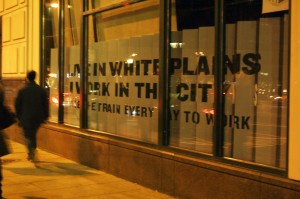White Plains’ vacant storefronts become canvas for Purchase students
Many vacant storefronts often look vaguely similar: uninviting, dusty windows through which scattered remnants of old furniture in an empty space are on display.
However, there are eight storefronts in downtown White Plains that don”™t bear any resemblance to that tiresome depiction.
As part of a new White Plains Business Improvement District-sponsored program called Art in Vacant Spaces, design students at Purchase College and a poet combined forces to transform the look and feel of the empty glass panes in some of the busiest shopping corridors in the city.
Brittany B. Brandwein, director of events and business promotions at the White Plains BID, said the idea for the project surfaced after receiving feedback from the community about whether anything could be done to improve the appearance of the city”™s empty storefronts, which in March was estimated to be anywhere between 10 and 22 percent in White Plains.
“The goal, ultimately, was to beautify the vacant space for the community, give them something nice to look at and also to bring attention to the spaces in a more positive way,” she said.
Eight storefronts spread out on Mamaroneck Avenue, Court Street, Main Street and Martine Avenue were chosen as the canvases for students in Warren Lehrer”™s community design class at the School of Art and Design on the SUNY campus in Purchase.
The artistic components were also left to Lehrer, an author and professor at Purchase, who came up with the idea to fuse poetry into the student-created designs for the storefronts and brought on Judith Sloan, a poet, oral historian and actress, to participate in the assignment.
Lehrer”™s concept for the project was rooted in the idea of “going into White Plains and talking to residents and people who work and commute to White Plains, get personal stories, do research on the city,” he said. “None of these (designs) really get too much into the why, but reflect on some of the shades, feelings, hopes around the vacancies.”
Lehrer said the challenge for the students was “how to make these poems live in a visual space” and in ways that are “engaging to people who are just walking down the street trying to get to the next place.”
Sloan, who was commissioned by the college to develop the poems, interviewed people in the community to develop a sense of their connection with White Plains.
One of the poems, for example, centered on the commute in and out of the city on the train, which was a central component to many of the connections people had with White Plains. One student translated and illustrated this poem into a lenticular design that from one angle reads, “I live in the city; I work in White Plains,” and from another angle reads, “I live in White Plains; I work in the city.”
The cost of materials for the project were largely covered by the BID and the art was printed at a discounted rate at PIP Printing in downtown White Plains, which also provided a storefront for the project.
Brandwein and Lehrer said that when they went back to take pictures and see how people reacted to the newly decorated shops, they both observed people doing double-takes and at times turning around to get a closer look.
“While none of these directly say, ”˜Please rent my space,”™ in a Zen kind of way, the best thing that could happen with these is for them to have to get taken down because the stores get rented,” Lehrer said.









